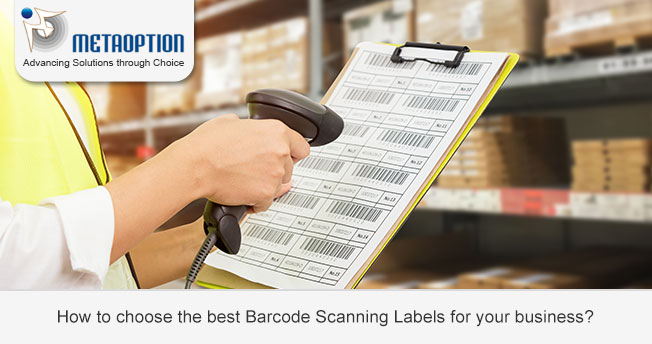Barcode Scanning Labels are used in a wide range of apps in warehouse businesses all over the world. From managing stock to tracking of the stock, to ticketing, retail, patient identification, and advertising, the usefulness of scanning labels is vast.

Whether you need basic stock scanning labels, custom scanning labels, or asset tags, knowing the answers to the following questions can help you in choosing the right label easily.
Q/A while choosing barcode scanning labels
Want to print 1D or 2D barcodes on the labels?
The first step in determining the type of scanning label you need is to figure out what type of barcode you will print on your labels. There are two basic types of barcodes: one-dimensional (1D) and two-dimensional (2D).
- 1D barcodes are linear barcodes that contain different symbols, each with its own purpose and set of limitations.
- The most common type of 2D barcode is the QR code which is read both horizontally and vertically. As 2D barcodes can store significantly more data than 1D barcodes
Requirement of scanning labels or scanning tags?
After figuring out the type of barcode you will print, ask yourself: Do I need a label or a tag? A scanning label is made up of face stock, adhesive, and release liner. The back of the face stock is coated with pressure-sensitive adhesive. This allows this media to adhere when you press it down on a surface. Whereas, a scanning tag does not have any adhesive or a release liner. It is sometimes referred to as a ticket. A tag will usually have a hang-hole.
Which material you should use for scanning labels?
Most papers are suitable for a wide variety of surfaces and temperature ranges. However, due to its inability to withstand extreme abrasion, moisture, or chemicals, and because it tears easily, paper is suitable for indoor use only. Whereas, Synthetic labels are more durable than paper. They resist moisture, heat, chemicals, tearing, and outdoor weather.
What type of adhesive do you need?
If you’ve decided you need a scanning tag, no adhesive is necessary; however if you’ve chosen scanning labels, you have many adhesive choices. The main types of adhesives are permanent, removable, repositionable (ultra-removable), freezer-grade, and patterned.
What type of barcode printer will you use?
There is more than one type of barcode printer, and they all have different capabilities and label sizes, depending on what you’ll be using barcodes for. Here are the standard options:
Desktop printer:
A desktop barcode printer is smaller than your typical office printer, a good fit for tight spaces, and for businesses that don’t need to print a high volume of barcodes each day. It’s a good choice for those in retail, healthcare, security, and travel/hospitality industries, and won’t break the bank.
Industrial printer:
These are larger workhorse printers that print barcodes at a high volume, at high speeds, and can do so 24/7 in harsh conditions, ensuring that your manufacturing operations will not stop. Industrial barcode printers also usually come with features like media hangers, rewinders, and peelers.
Mobile printer:
Best used for printing barcodes on the go, mobile barcode printers are small but durable, able to withstand outdoor conditions and the shock from falls. These can be used in a number of fields, including transportation and logistics, healthcare, and government.
For more information and tailored demonstration contact us today at MetaOption.


